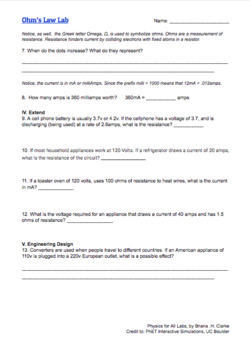Phet Ohm's Law Lab
Physics For All
84 Followers
Grade Levels
9th - 11th, Homeschool
Subjects
Resource Type
Standards
NGSSHS-PS3-1
Formats Included
- Word Document File
- Internet Activities
Pages
2 pages
Physics For All
84 Followers
Compatible with Digital Devices
The Teacher-Author has indicated that this resource can be used for device-based learning.
Description
**Best used on conjunction with Circuits Lab
Made For Distance Learning:
This lab is 1 of aset of 20, which was made to pair with freePhET online simulations, which allow hands on engagement in a distance learning setting.
Chromebook and tablet accessible. Simply upload to google classroom. Make a student copy and let students fill in. Answer Key Included (So copy paste in a safe space :)
Lab Objectives:
HS-PS3-1
- Students will be able to define voltage, current, and resistance.
- Students will find that current (i) is indirectly dependent on resistance (r)
- Students will find that current (i) is directly dependent on voltage (v)
- Students will practice Ohm’s Law
This curriculum is:
- 5 Es Structured
- print ready/ No notebook needed
- Inquiry driven
- Student centered, self paced
- No set-up of materials required
------
If you enjoy this lab, please rate and review. Also see us on TPT or Amazon for a physical workbook of same structured labs.
Total Pages
2 pages
Answer Key
Included
Teaching Duration
45 minutes
Report this resource to TPT
Reported resources will be reviewed by our team. Report this resource to let us know if this resource violates TPT’s content guidelines.
Standards
to see state-specific standards (only available in the US).
NGSSHS-PS3-1
Create a computational model to calculate the change in the energy of one component in a system when the change in energy of the other component(s) and energy flows in and out of the system are known. Emphasis is on explaining the meaning of mathematical expressions used in the model. Assessment is limited to basic algebraic expressions or computations; to systems of two or three components; and to thermal energy, kinetic energy, and/or the energies in gravitational, magnetic, or electric fields.




